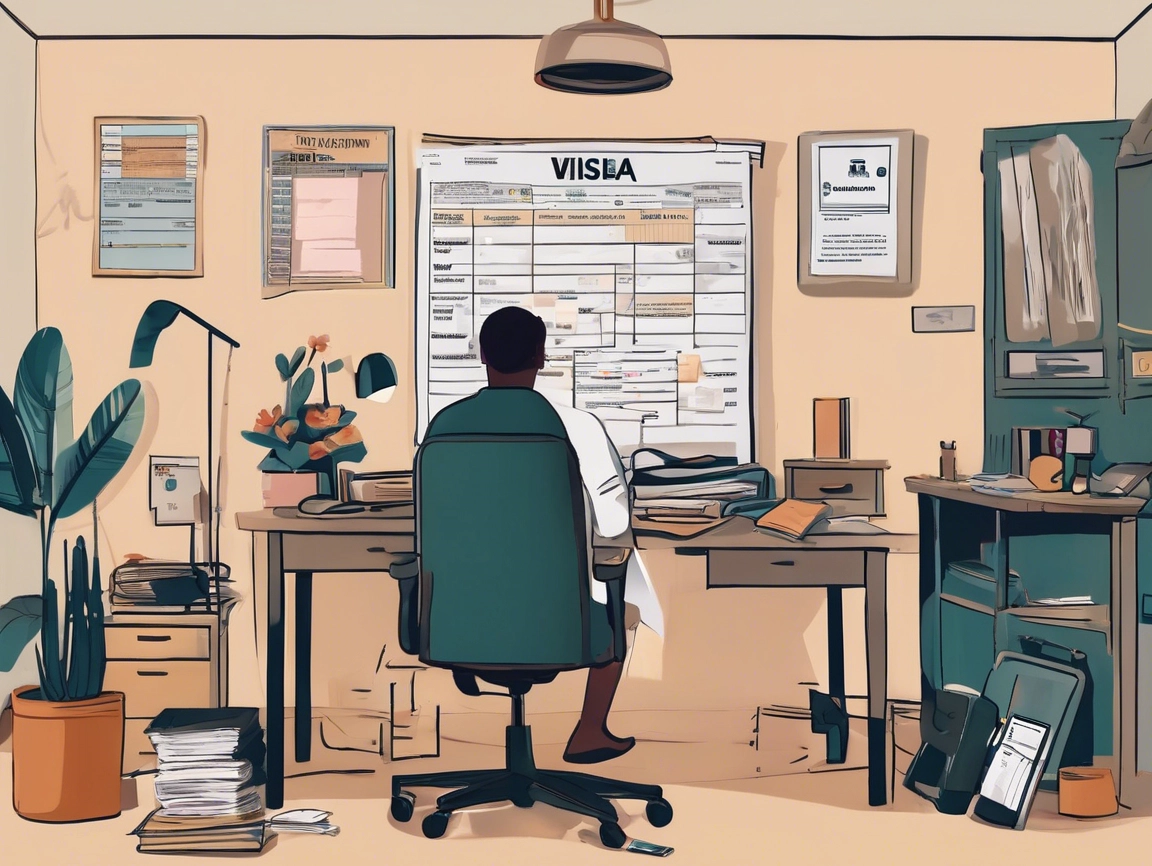Issuance of a New Work Permit – Domestic Workers
Getting a new work permit for your domestic worker can feel overwhelming, but it doesn’t have to be. This guide is for employers who need to secure proper work authorization for their household staff, whether you’re hiring a nanny, housekeeper, or caregiver for the first time.
The domestic worker work permit application process involves specific steps that many employers find confusing. You’ll need to understand the exact documentation requirements and stay compliant with local labor laws to avoid costly delays or rejections.
We’ll walk you through the essential work permit documentation you need to gather, break down the step-by-step application process, and highlight common work permit application mistakes that can derail your timeline. By the end, you’ll know exactly what it takes to get your domestic helper permit approved quickly and legally.
Understanding Work Permit Requirements for Domestic Workers
Legal Framework and Regulations Governing Domestic Worker Permits
The domestic worker work permit system operates under a comprehensive legal framework designed to protect both employers and workers while maintaining immigration control. Most countries have specific regulations that classify domestic workers as a distinct category of foreign workers, separate from other employment-based visa categories. These regulations typically fall under immigration law, labor law, and sometimes specific domestic worker protection acts.
The legal structure usually requires employers to demonstrate their genuine need for domestic help and their ability to provide appropriate working conditions and compensation. Many jurisdictions have implemented minimum wage requirements, mandatory rest periods, and housing standards that must be met before a work permit application can be approved. Some regions also require employers to prove they’ve attempted to hire local workers before seeking foreign domestic help.
Recent legislative changes in many countries have strengthened worker protections, including provisions for contract transparency, grievance procedures, and pathways to permanent residence. These laws often include penalties for employers who violate permit conditions or exploit workers.
Eligibility Criteria for Employers and Workers
Both employers and domestic workers must meet specific eligibility criteria before the work permit application process can begin. Employers typically need to demonstrate financial stability through bank statements, tax returns, or employment verification showing they can support a domestic worker’s salary and benefits. Many jurisdictions also require employers to have legal resident or citizen status and maintain a clean criminal background check.
Worker eligibility requirements usually include minimum age restrictions (typically 23-25 years), educational qualifications ranging from elementary to high school completion, and relevant work experience in domestic services. Health screenings and medical examinations are standard requirements, often including tests for communicable diseases and physical fitness assessments.
Language proficiency requirements vary significantly by country, with some requiring basic conversation skills in the local language while others have no language prerequisites. Criminal background checks from the worker’s home country are universally required, often with specific validity periods and authentication requirements.
Some countries maintain bilateral agreements with specific nations that streamline the eligibility process, while others have restricted lists of eligible countries based on diplomatic relations or previous compliance rates.
Required Documentation and Supporting Materials
The domestic worker permit documentation requirements are extensive and must be carefully prepared to avoid application delays. Employers must typically provide proof of identity through passports or national ID cards, residential documentation such as property ownership papers or lease agreements, and financial documentation including bank statements covering the past 3-6 months.
Employment contracts form the cornerstone of domestic worker permit applications. These contracts must specify working hours, duties, salary, accommodation arrangements, and termination procedures. Many jurisdictions provide standardized contract templates that must be used, while others allow customized agreements provided they meet minimum legal requirements.
Workers must submit educational certificates, often requiring translation and authentication through consular services. Medical examination reports from approved physicians or clinics are mandatory, typically including chest X-rays, blood tests, and general health assessments. These medical documents usually have strict validity periods, often 3-6 months from the date of examination.
Passport validity requirements typically mandate at least 18 months of remaining validity, and workers must often provide multiple passport-sized photographs meeting specific technical requirements. Birth certificates, marriage certificates (if applicable), and police clearance certificates from all countries where the worker has resided for more than six months are standard requirements.
Processing Timeline and Associated Fees
Work permit application processing times vary significantly depending on the jurisdiction and application complexity. Standard processing typically ranges from 4-12 weeks, though expedited services may be available for additional fees. Peak application periods, usually coinciding with holiday seasons or school year starts, can extend processing times considerably.
Application fees structure often includes multiple components: base application fees, medical examination costs, document authentication charges, and potentially interview fees. Total costs can range from several hundred to several thousand dollars, depending on the country and additional services required.
Some jurisdictions offer different processing tiers with varying timelines and costs. Standard processing might take 8-10 weeks at the base fee, while expedited processing could reduce this to 4-6 weeks for 50-100% additional cost. Emergency processing for urgent situations may be available in exceptional circumstances.
Employers should budget for additional costs including document translation, notarization, courier services, and potential resubmission fees if applications are rejected due to incomplete documentation. Some countries also require security deposits or bonds that are refundable upon successful completion of the employment period.
Payment methods vary by jurisdiction, with some accepting only certified checks or money orders while others allow credit card payments or bank transfers. Fee schedules are subject to periodic updates, so applicants should verify current rates before submitting applications.
Step-by-Step Application Process for New Work Permits
Initial Registration and Account Setup Procedures
Starting your domestic worker work permit application begins with creating an official account through the government’s online portal. You’ll need to navigate to the designated immigration website and select the “New User Registration” option. Have your personal identification documents ready, including your passport, national ID, and contact information.
The registration process requires you to provide basic details such as your full name, date of birth, nationality, and current address. Create a strong password that meets the system’s security requirements – typically including uppercase letters, numbers, and special characters. Write down your login credentials and store them securely, as you’ll need them throughout the application process.
Once registered, verify your email address by clicking the confirmation link sent to your inbox. This activation step is crucial – without email verification, you won’t be able to access the full application features. Some systems also require phone number verification through SMS codes.
After successful registration, log into your account and complete your profile information. This includes uploading a recent passport-sized photograph that meets the specified dimensions and background requirements. The system will guide you through setting up security questions and may require two-factor authentication for added protection.
Take time to familiarize yourself with the portal’s layout and available resources. Most platforms offer user guides, FAQ sections, and help tutorials that can save you time later in the process.
Completing Application Forms Accurately and Efficiently
The domestic worker work permit application form contains multiple sections that require precise information. Start by gathering all necessary details about your intended employment, including your employer’s full legal name, business registration number, and complete address. Any discrepancies between your application and supporting documents can cause significant delays.
Personal information sections must match exactly with your passport and other official documents. Double-check spellings of names, dates, and addresses before moving to the next section. The system typically saves your progress automatically, but it’s wise to save manually after completing each major section.
Employment details require specific information about your job role, salary, working hours, and accommodation arrangements. Be precise when describing your duties – generic descriptions like “general housework” may not meet the specific requirements. Instead, provide detailed information such as “childcare for two children ages 3 and 6, meal preparation, light housekeeping, and laundry duties.”
Financial information sections need accurate salary figures, including basic pay, overtime rates, and any additional benefits. These amounts must align with minimum wage requirements and standard employment practices in your jurisdiction. Include details about accommodation provisions, whether you’ll live with the employer or receive a housing allowance.
Review each section carefully before submission. Many applications get rejected for simple errors like incorrect dates or mismatched information. Use the preview function if available to see how your completed application appears before final submission.
Document Submission and Verification Requirements
Proper documentation forms the backbone of any successful work permit application process. Start by creating a comprehensive checklist of required documents, which typically includes your passport with at least six months validity, educational certificates, medical examination reports, and police clearance certificates from your home country.
Your passport must have blank pages for visa stamps and endorsements. If your passport expires within the required validity period, renew it before starting the application process. Certified copies of all documents are usually required – these must be notarized or certified by authorized government offices.
Medical examinations must be conducted by approved healthcare providers and include tests for communicable diseases. The medical report typically remains valid for three to six months, so time your examination accordingly. Some jurisdictions require specific vaccinations or additional health screenings.
Employment-related documents include your signed employment contract, job offer letter, and your employer’s business license or registration documents. Your employer may also need to provide proof of financial capability to support your employment, such as bank statements or tax returns.
Upload documents in the specified formats – usually PDF or JPEG files under certain size limits. Ensure all documents are clear, legible, and properly oriented. Blurry or poorly scanned documents often result in application delays or rejections.
Create a systematic filing system to track which documents you’ve submitted and their status within the application system. Many portals provide real-time updates on document verification progress, allowing you to address any issues promptly.
Essential Documentation and Legal Compliance
Worker Identification and Qualification Certificates
Getting your paperwork right starts with proper identification documents. You’ll need a valid passport with at least six months remaining before expiration, plus certified copies of birth certificates and educational credentials. For domestic worker work permit applications, qualification certificates play a crucial role in demonstrating competency.
Training certificates from recognized institutions carry significant weight during the review process. These Some jurisdictions require completion of mandatory orientation programs before domestic worker visa application submission.
Professional references from previous employers strengthen your application considerably. Include contact information and detailed letters describing work performance, reliability, and character. Academic transcripts, even for basic education levels, help establish educational background and language proficiency requirements.
Employer Sponsorship and Financial Guarantee Documents
Your sponsoring employer must provide comprehensive financial documentation proving their ability to support the employment arrangement. Bank statements covering the last three to six months demonstrate financial stability and capacity to pay agreed wages consistently.
Employment contracts require specific legal language addressing salary, working hours, accommodation arrangements, and termination procedures. These contracts must comply with local labor laws and clearly outline both parties’ rights and responsibilities. Work permit legal compliance demands that salary levels meet minimum wage requirements established by immigration authorities.
Financial guarantee letters from banks or certified financial institutions often supplement employer documentation. These guarantees protect workers by ensuring payment of wages and potential repatriation costs. Some regions require employers to deposit security bonds before domestic staff work authorization approval.
Medical Examination and Health Clearance Requirements
Health screenings represent a non-negotiable component of work permit documentation. Approved medical practitioners must conduct these examinations, which typically include general physical assessments, chest X-rays, and blood tests for communicable diseases.
Vaccination records need updating according to local health department requirements. Common mandatory vaccinations include hepatitis A and B, tuberculosis screening, and seasonal influenza shots.
Medical certificates must be recent, usually issued within 30-90 days of application submission. Pre-existing medical conditions don’t automatically disqualify applicants but require detailed documentation from treating physicians explaining how conditions are managed and whether they affect work capacity.
Background Check and Security Verification Procedures
Criminal background checks from your country of origin are mandatory for household worker permit applications. These documents require official translation and authentication through embassy or consulate offices. Police clearance certificates typically remain valid for six months from issuance date.
Security verification extends beyond criminal history to include employment verification and character references. Immigration authorities may contact previous employers, schools, or community leaders to confirm information provided in applications. Social media screening has become increasingly common during background verification processes.
International criminal database checks may be conducted for applicants who have lived in multiple countries. Fingerprinting requirements vary by jurisdiction but are standard practice for positions involving access to family homes and personal property.
Insurance Coverage and Employment Contract Specifications
Comprehensive insurance coverage protects both workers and employers throughout the employment relationship. Health insurance must cover routine medical care, emergency treatments, and specialist consultations. Some jurisdictions mandate specific coverage levels or require enrollment in national health systems.
Workers’ compensation insurance addresses workplace injuries and occupational hazards. This coverage becomes particularly important for domestic workers who may face unique risks in residential settings. Professional liability insurance protects against claims related to property damage or negligence during work performance.
Employment contracts must specify insurance responsibilities, premium payments, and coverage limitations. Life insurance requirements vary but often form part of comprehensive employment packages. Repatriation insurance ensures workers can return to their home countries if employment terminates unexpectedly.
Contract specifications should address overtime policies, vacation entitlements, and dispute resolution procedures. Clear documentation of living arrangements, meal provisions, and personal time helps prevent misunderstandings that could jeopardize work permit status.
Avoiding Common Application Mistakes and Delays
Incomplete Documentation and Missing Information Errors
The most frequent stumbling block in the domestic worker work permit application process is submitting incomplete documentation. Many employers rush through their applications without double-checking every required document, leading to automatic rejections and lengthy resubmission processes.
Your domestic helper permit requirements checklist should include the worker’s complete passport (with at least 18 months validity), educational certificates, medical examination reports, and police clearance certificates from their home country. Missing even one document means starting the entire process over again.
Pay special attention to document authentication requirements. Many applicants forget that foreign documents need proper apostille or embassy certification before submission. Employment contracts must contain specific clauses about working hours, salary details, and accommodation arrangements. Generic contracts copied from online templates often lack jurisdiction-specific requirements that immigration officers look for during review.
Common Documentation Pitfalls:
- Expired or poor-quality document copies
- Missing translations for non-English documents
- Unsigned or incorrectly dated employment contracts
- Incomplete medical reports lacking required health screenings
- Photos that don’t meet biometric specifications
Incorrect Fee Payments and Processing Delays
Fee payment errors cause significant delays in work permit application processing. Each jurisdiction has specific payment methods, amounts, and timing requirements that change regularly. Many applicants still submit outdated fee amounts or use incorrect payment channels.
Payment receipts must match the applicant’s name and case number exactly. Banks often truncate long names on electronic transfers, creating mismatches that require manual verification and additional processing time. Always verify current fee schedules on official government websites before making payments, as third-party sites frequently display outdated information.
Processing fees typically include application fees, security deposits, and administrative charges. Some regions require separate payments for different application stages, while others accept lump-sum payments. Understanding your local payment structure prevents costly delays and resubmissions.
Payment Best Practices:
- Use official government payment portals only
- Save all payment confirmation receipts
- Verify fee amounts on government websites
- Ensure exact name matching on payment records
Non-Compliance with Labor Law Requirements
Work permit legal compliance goes beyond immigration requirements and extends into local labor law territories. Many employers focus solely on immigration paperwork while overlooking mandatory labor protections that can invalidate their entire application.
Domestic staff work authorization requires compliance with minimum wage laws, working hour restrictions, and mandatory rest periods. Employment contracts must reflect actual working conditions, not idealized arrangements that look good on paper. Immigration officers increasingly cross-reference work permit applications with labor department databases to identify non-compliant employers.
Insurance coverage represents another compliance area where applications frequently fail. Most jurisdictions require comprehensive health insurance, workers’ compensation coverage, and liability insurance for household worker permits. These policies must be active before application submission and maintained throughout the permit validity period.
Worker accommodation standards also fall under compliance scrutiny. Living space requirements, privacy provisions, and safety standards must meet local housing regulations. Immigration authorities may conduct site inspections during the application review process to verify compliance with domestic worker accommodation standards.
Regular salary payments through official banking channels create necessary paper trails for permit renewals and compliance audits. Cash payments, even when properly documented, raise red flags during application reviews and can lead to rejection despite meeting other requirements.
Post-Approval Procedures and Ongoing Obligations
Work Permit Collection and Activation Process
Once your domestic worker work permit application gets approved, you’ll receive notification to collect the physical permit. Most countries require employers to pick up the permit within a specific timeframe, typically 30 days from approval notification. The collection process usually involves visiting the immigration office with proper identification and the approval reference number.
The activation process begins immediately upon collection. Your domestic worker must enter the country within the permit’s validity period, and some jurisdictions require registration within 14 days of arrival. Keep detailed records of arrival dates, as these become important for future renewal applications and legal compliance tracking.
Employer Reporting Requirements and Regular Updates
Employers face ongoing reporting obligations that extend well beyond the initial work permit issuance. Most immigration authorities require quarterly or annual updates about your domestic worker’s employment status, residential address changes, and any modifications to working conditions.
Key reporting requirements include:
- Employment status confirmation every 6-12 months
- Address change notifications within 30 days
- Salary adjustment reports if wages exceed permitted thresholds
- Medical examination updates as required by local regulations
- Security clearance renewals where applicable
Missing these reporting deadlines can result in permit cancellation, fines, or difficulties with future domestic worker visa applications. Set up calendar reminders well before each deadline to avoid complications.
Renewal Procedures and Timeline Management
Work permit renewal requires careful timing and preparation. Most permits need renewal 2-3 months before expiration, and the process can take several weeks to complete. Starting the renewal process early prevents work authorization gaps that could leave your domestic worker in illegal status.
The renewal documentation typically includes:
- Updated employment contracts
- Recent medical certificates
- Proof of continuous employment
- Updated salary certificates
- Clean criminal background checks
Some jurisdictions allow online renewal for straightforward cases, while others require in-person appointments. Check if your domestic worker qualifies for expedited processing, especially if they’ve maintained continuous legal status without violations.
Worker Rights and Protection Mechanisms
Domestic workers hold specific rights that employers must respect throughout the permit period. These protections include fair wage payment, reasonable working hours, safe working conditions, and access to medical care. Many countries mandate weekly rest days and annual leave entitlements that cannot be waived.
Workers have the right to file complaints with labor authorities if employers violate permit conditions or employment standards. They can also request permit transfers to new employers under certain circumstances, though this process requires approval from immigration authorities and may involve waiting periods.
Emergency protection mechanisms exist for domestic workers facing abuse or exploitation. Most jurisdictions provide temporary shelter services, legal aid access, and expedited permit processing for workers escaping dangerous situations. Understanding these protections helps create a safer working environment and demonstrates compliance with domestic staff work authorization requirements.
Getting a new work permit for domestic workers doesn’t have to be overwhelming when you know what steps to take. The key is understanding the specific requirements, gathering all your documents ahead of time, and following the application process carefully. Small mistakes can lead to big delays, so double-checking everything before you submit makes a real difference.
Once you get approval, remember that your responsibilities don’t end there. Stay on top of renewal dates, keep your documentation current, and make sure you’re meeting all ongoing legal requirements. Taking care of these details now saves you from headaches later and keeps everything running smoothly for both employers and workers.
img{
width:100%;
}
table, td, th {
border: 1px solid;
}
table {
width: 100%;
border-collapse: collapse;
}











